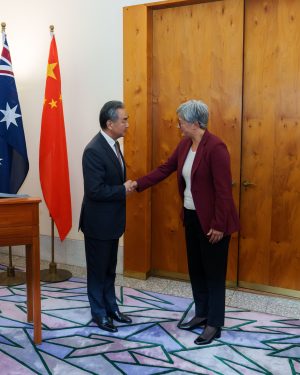Australia received its most senior Chinese leadership visit in nearly seven years Wednesday, with stability a key theme of the discussions between the countries’ foreign ministers.
China’s Wang Yi met with his counterpart Penny Wong in Canberra on his tour of Australia and New Zealand. It was the highest-level meeting in Australia between the nations since 2017 and comes as relations continue to thaw after a tumultuous period under Australia’s former government in which trade measures were imposed on a raft of Australian products and security tensions were escalating around the region.
“A stable relationship between Australia and China doesn’t just happen, it needs ongoing work,” Wong said at a news conference after the meeting. “And this was the latest meeting in that process.”
Wong acknowledged important differences remained between the countries, but she said work to uphold their common interests would continue. “Australia will always be Australia and China will always be China. However, we will cooperate where we can but disagree where we must and manage these differences wisely,” she said.
Among the differences raised Wednesday was the case of detained Australian Yang Hengjun, who was found guilty of espionage in a closed trial and sentenced to death with a two-year reprieve in February.
Wong said Australians were shocked by the sentence and the government would not “walk away from our advocacy for Doctor Yang.”
Also discussed was the removal of the last trade tariffs – on wine, rock lobster, and some abattoirs – that China imposed in 2020 during the most recent nadir in the bilateral relationship. The trade restrictions have cost the Australian economy an estimated 20 billion Australian dollars (US$13 billion).
“We’re very proud of our wine and our lobster and our beef and we think Chinese consumers would benefit from all of those products having access to the Chinese market without any impediments,” Wong said. “We think it’s in both countries’ interests.”
Earlier, Wang said Australia and China could learn from their past tensions.
“The past twists and turns over the decade leave us with lessons to draw on as well as valuable experience,” he said before his meeting with Wong. “Relations are now on the right track, so we shouldn’t hesitate, we shouldn’t let it veer off course and shouldn’t go backwards.”
Outside the Chinese Embassy in Canberra, dozens of protesters cloaked in Tibetan and Uyghur flags protested Wang’s visit and urged the Australian government not to overlook China’s human rights abuses.
The Australian Broadcasting Corporation reported that police removed several people who tried to get inside the diplomatic compound.
Wang is the most senior Chinese official to visit Australia since then-Premier Li Keqiang met with then-Prime Minister Malcolm Turnbull in 2017.
Plans for current Chinese Premier Li Qiang to visit Australia were “on track,” according to both foreign ministers. It is expected in mid-2024.
Wang briefly met Prime Minister Anthony Albanese later Wednesday before travelling to Sydney for further meetings.
Earlier, in New Zealand, Wang met counterpart Winston Peters, Prime Minister Christopher Luxon, and the country’s trade minister.

































